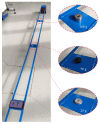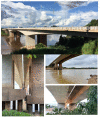Smartphone Application for Structural Health Monitoring of Bridges
- PMID: 36366182
- PMCID: PMC9655388
- DOI: 10.3390/s22218483
Smartphone Application for Structural Health Monitoring of Bridges
Abstract
The broad availability and low cost of smartphones have justified their use for structural health monitoring (SHM) of bridges. This paper presents a smartphone application called App4SHM, as a customized SHM process for damage detection. App4SHM interrogates the phone's internal accelerometer to measure accelerations, estimates the natural frequencies, and compares them with a reference data set through a machine learning algorithm properly trained to detect damage in almost real time. The application is tested on data sets from a laboratory beam structure and two twin post-tensioned concrete bridges. The results show that App4SHM retrieves the natural frequencies with reliable precision and performs accurate damage detection, promising to be a low-cost solution for long-term SHM. It can also be used in the context of scheduled bridge inspections or to assess bridges' condition after catastrophic events.
Keywords: damage identification; machine learning; smartphone application; structural dynamics; structural health monitoring.
Conflict of interest statement
The authors declare no conflict of interest. The funders had no role in the design of the study; in the collection, analyses, or interpretation of data; in the writing of the manuscript; or in the decision to publish the results.
Figures


















Similar articles
-
Smartphone Prospects in Bridge Structural Health Monitoring, a Literature Review.Sensors (Basel). 2024 May 21;24(11):3287. doi: 10.3390/s24113287. Sensors (Basel). 2024. PMID: 38894080 Free PMC article. Review.
-
Integration of Railway Bridge Structural Health Monitoring into the Internet of Things with a Digital Twin: A Case Study.Sensors (Basel). 2024 Mar 26;24(7):2115. doi: 10.3390/s24072115. Sensors (Basel). 2024. PMID: 38610327 Free PMC article.
-
Deep Learning for Structural Health Monitoring: Data, Algorithms, Applications, Challenges, and Trends.Sensors (Basel). 2023 Oct 30;23(21):8824. doi: 10.3390/s23218824. Sensors (Basel). 2023. PMID: 37960524 Free PMC article. Review.
-
Citizen sensors for SHM: use of accelerometer data from smartphones.Sensors (Basel). 2015 Jan 29;15(2):2980-98. doi: 10.3390/s150202980. Sensors (Basel). 2015. PMID: 25643056 Free PMC article.
-
Opportunistic Environmental Sensing with Smartphones: a Critical Review of Current Literature and Applications.Curr Environ Health Rep. 2017 Sep;4(3):306-318. doi: 10.1007/s40572-017-0158-8. Curr Environ Health Rep. 2017. PMID: 28879432 Review.
Cited by
-
Subspace Identification of Bridge Frequencies Based on the Dimensionless Response of a Two-Axle Vehicle.Sensors (Basel). 2024 Mar 18;24(6):1946. doi: 10.3390/s24061946. Sensors (Basel). 2024. PMID: 38544209 Free PMC article.
-
Toward Structural Health Monitoring with the MyShake Smartphone Network.Sensors (Basel). 2023 Oct 24;23(21):8668. doi: 10.3390/s23218668. Sensors (Basel). 2023. PMID: 37960368 Free PMC article.
-
Smartphone Prospects in Bridge Structural Health Monitoring, a Literature Review.Sensors (Basel). 2024 May 21;24(11):3287. doi: 10.3390/s24113287. Sensors (Basel). 2024. PMID: 38894080 Free PMC article. Review.
References
-
- Figueiredo E., Moldovan I., Marques M.B. Condition Assessment of Bridges: Past, Present and Future A Complementary Approach. Católica Editora; Lisboa, Portugal: 2013.
-
- Thompson P.D., Small E.P., Johnson M., Marshall A.R. The Pontis Bridge Management System. Struct. Eng. Int. 1998;8:303–308. doi: 10.2749/101686698780488758. - DOI
-
- Farrar C.R., Worden K. Structural Health Monitoring: A Machine Learning Perspective. John Wiley & Sons, Ltd.; Hoboken, NJ, USA: 2013.
-
- Rytter A., Kirkegaard P.H.P. Ph.D. Thesis. Aalborg University; Aalborg, Denmark: 1994. Vibration Based Inspection of Civil Engineering Structures.
MeSH terms
Grants and funding
LinkOut - more resources
Full Text Sources

